![[Apollo 11 Logo]](thumbnail/apollo_11_patch.gif)
![[Crew of Apollo 11]](thumbnail/a11crew.gif)
![[Apollo 30th Anniversary Logo]](thumbnail/apollo_30th_logo.gif)
![[Apollo 11 Logo]](thumbnail/apollo_11_patch.gif)
![[Crew of Apollo 11]](thumbnail/a11crew.gif)
![[Apollo 30th Anniversary Logo]](thumbnail/apollo_30th_logo.gif)
The picture above shows the crew of Apollo 11:
Commander Neil A. Armstrong, 38, a civilian who'd flown previously on Gemini 8,
Command Module Pilot Michael Collins, 38, a USAF Lt. Colonel who'd flown Gemini 10,
Lunar Module Pilot Edwin E. Aldrin, Jr., 39, a USAF Colonel who'd flown Gemini 12.
Photograph taken May 1, 1969.
(NASA photo ID S69-31739)
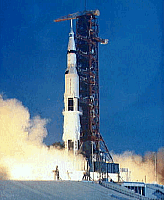
The first human journey to the surface of the
Moon began at Pad A, Launch Complex 39, Kennedy Space Center, Florida with the
liftoff of Apollo 11 on a Saturn V booster at 9:32 a.m.
EDT (13:32 UT) on a clear sunny Wednesday, 16 July 1969.
(NASA photo ID S69-39525)
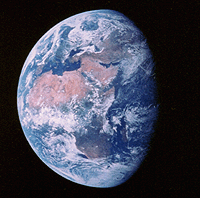
The Apollo spacecraft reached Earth parking orbit after 11 minutes.
After one and a half orbits the Saturn thrusters fired and the
astronauts began their journey to the Moon.
This spectacular photo of the Earth was taken from 158,000 km (98,000 miles) during the
Apollo 11 translunar injection on July 16. Most of Africa and parts of
Europe and Asia are visible.
(NASA photo ID AS11-36-5355)
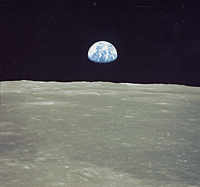
On July 20, 1969, after a four day trip, the Apollo astronauts arrived at the Moon.
This photo of Earthrise over the lunar horizon taken from the orbiting Command Module
is one of the most famous images returned from the space program, although even the
astronauts themselves cannot remember who actually took the picture. The lunar terrain
shown, centered at 85 degrees east longitude and 3 degrees north latitude on the nearside
of the Moon is in the area of Smyth's Sea.
(NASA photo ID AS11-44-6552)
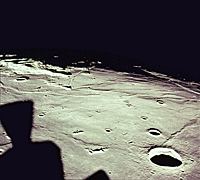
This west-looking image of the landing site
in the southwestern Sea of Tranquility was taken from the lunar module
one orbit before descent, while still docked to the command module.
The Tranquility base site is near the shadow line, just to the right of center.
The large crater at the lower right is Maskelyne. The large black object in the
lower left is not a shadow but a LM thruster in the camera field of view.
(NASA photo ID AS11-37-5437)
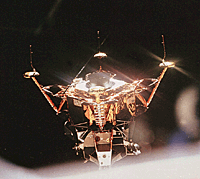
At 1:47 pm EDT, July 20, the Lunar Module "Eagle" carrying Neil Armstrong
and Edwin Aldrin, separated from the Command Module "Columbia". Michael Collins,
aboard the Columbia, took this picture of the LM as it prepared for its descent
to the Moon. "You cats take it easy on the lunar surface", Collins said as he
released the LM. Collins did a visual inspection of the lunar module and
said, "I think you've got a fine looking machine there, Eagle, despite the
fact that you're upside-down." "Somebody's upside-down", Armstrong replied.
The lunar horizon can be seen in the background.
(NASA photo ID AS11-44-6574)
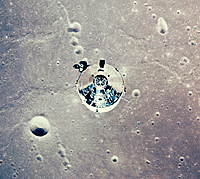
This photograph of the Command Module was taken from the LM after
separation. The lunar surface below is in the north central Sea of Fertility,
centered at 51 degree east longitude, 1 degree north latitude. Over the next
day, Michael Collins would orbit the Moon while his colleagues walked on its
surface. With no video monitor onboard he could not watch the proceedings but
only listen in on the radio communications - and enjoy the sensation of
orbiting the Moon solo, the first time anyone had been the only person in
lunar orbit.
(NASA photo ID AS11-37-5445)
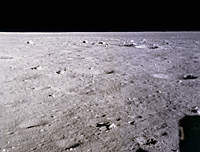
"Houston, Tranquility Base here. The Eagle has landed."
These words ushered in a new era of human exploration at 4:18 p.m. EDT on July 20,
as the first crewed flight to the Moon touched down after flying longer than
planned, down to the last 40 seconds of fuel, to avoid a field of boulders and a
large crater. Charles Duke, the Capcom (capsule communicator) back in Houston,
replied, "Roger, Tranquility. We copy you on the ground. You got a bunch of guys
about to turn blue. We're breathing again." This picture, taken from the LM
window shortly before touchdown, shows the surface of the Moon near the touchdown
point in the Sea of Tranquility.
(NASA photo ID AS11-37-5458)
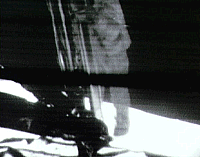
"That's one small step for man, one giant leap for mankind."
At 10:56 p.m. EDT on July 20, 1969, Neil Armstrong became the first human to set
foot on the Moon. This image was taken from the telecast of the event, watched by
over half a billion people around the world. Armstrong composed the quote after
landing on the Moon, he had meant to say, "That's one small step for aman ...".
The pictures were taken by the Apollo lunar surface camera, mounted on one of the
LM legs. The black bar running through the center of the picture is an anomaly
in the Goldstone ground data system.
(NASA photo ID S69-42583)
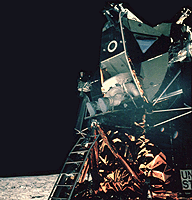
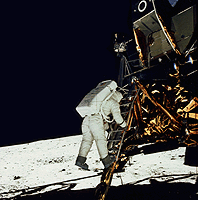
Aldrin joined Armstrong on the surface about nineteen minutes later,
calling it "Magnificent desolation".
As he left the LM, Aldrin said, "Now I want to back up and
partially close the hatch - making sure not to lock it on my way out."
"A particularly good thought." laughed Armstrong. Asked later on why they bothered closing the
hatch, Armstrong said it was to avoid having someone ask "Were you born in a barn?"
(NASA photo IDs AS11-40-5863 and AS11-40-5868)
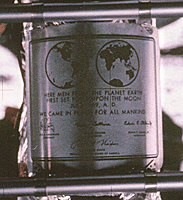
The astronauts removed a sheet of stainless steel to unveil the plaque affixed
to the lunar module leg under the descent ladder and read to the television audience:
"Here men from the planet Earth first set foot upon the Moon, July 1969 A.D.
We came in peace for all mankind." It was signed by Armstrong, Collins, Aldrin, and
President Richard Nixon.
(NASA photo ID AS11-40-5899)
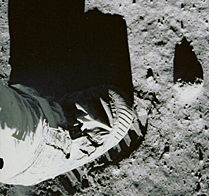
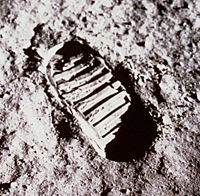
The footprints left by the astronauts in the Sea of Tranquility are more permanent
than most solid structures on Earth. Barring a chance meteorite impact, these
impressions in the lunar soil will probably last for millions of years.
Photographs of the footprints were actually part of a planned experiment by Aldrin to
study the nature of the lunar dust and the effects of pressure on the surface.
(NASA photo ID's AS11-40-5880 and AS11-40-5878)
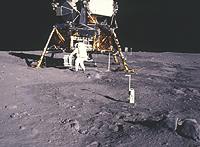
Here Aldrin is unloading the passive seismometer of the Early Apollo Scientific
Experiments Package (EASEP) from the lunar module equipment bay. The white
apparatus in the foreground is the 35 mm stereo close-up camera. Beyond the
right leg is the solar wind experiment, and beyond that the
lunar surface TV camera. The LM legs are wrapped in foil
to provide thermal insulation. There is a split rock in the lower right
of the frame which is presumably ejecta from a nearby impact crater.
(NASA photo ID AS11-40-5931)
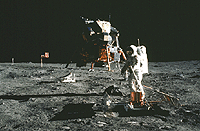
In the couple hours that Aldrin and Armstrong were on the Moon, there
was little time to set up scientific experiments, but a small
package (the EASEP, or Early Apollo Scientific Experiments
Package) was deployed. Aldrin is shown here setting up the
Passive Seismic Experiments Package. Behind Aldrin to the left is the
Laser Ranging Retro-Reflector. The flag and the lunar surface television
camera are left of the LM. This mission paved the way for the more
extensive scientific studies done on later Apollo missions.
(NASA photo ID AS11-40-5949)
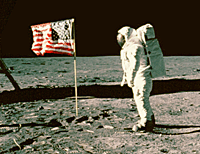
Aldrin posed for this picture next to the U.S. flag.
The rod to hold the flag out horizontally would not extend fully, so the flag
ended up with a slight waviness, giving the appearance of being windblown.
The flag itself was difficult to erect, it was very hard to
penetrate beyond about 6 to 8 inches into the lunar soil.
(NASA Photo ID AS11-40-5875)
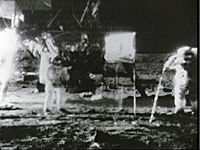
Millions of Earthlings watched the drama unfold on TV images taken
by the black and white lunar surface camera. Here, Armstrong is standing in the
center, and Aldrin is saluting President
Richard M. Nixon, who had just spoken to the two astronauts by radio
telephone from the White House: "Hello, Neil and Buzz. I'm talking to you by
telephone from the Oval Room at the White House, and this certainly has to be
the most historic telephone call ever made ..... Because of what you have done,
the heavens have become a part of man's world .......".
Armstrong replied, "Thank you, Mr. President. It's a great honor and privilege
for us to be here representing not only the United States but men of peace of all
nations, and with interests and the curiosity and with the vision for the future."
(NASA photo ID S69-39562)
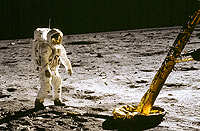
Walking on the lunar surface was not difficult, but took a little practice.
Despite the fact that the backpacks and astronauts only weighed 1/6 on their
350 pound Earth weight, their center of gravity was shifted so they had to
lean slightly forward to balance, and they still had to overcome the inertia
of all that mass, so stopping usually took a few steps. Here Aldrin is
walking in the typical bent posture near the leg of the lunar module.
Footprints are clearly visible in the foreground.
(NASA photo ID AS11-40-5902)
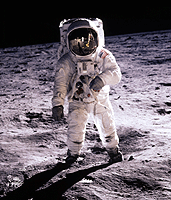
Neil Armstrong took this picture of Edwin Aldrin, showing a reflection in
Aldrin's visor of Armstrong and the Lunar Module. This is one of the few
photographs showing Armstrong (who carried the camera most of the time) on the Moon.
The tasks assigned to both astronauts were carefully choreographed and
practiced back on Earth, and Aldrin was busy setting up scientific experiments
among other responsibilities. Apparently taking pictures was not as carefully planned.
Aldrin later said, "My fault, perhaps, but we had never simulated this in
training."
(NASA photo ID AS11-40-5903)
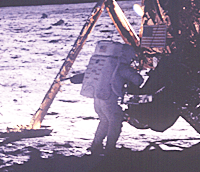
Armstrong was photographed here at the Modular Equipment Stowage Assembly
(MESA) on the lunar module, packing the bulk rock and soil sample he had
collected. Aldrin took this picture as part of a series of panoramas of
the area around the Tranquility Base landing site. Armstrong is in the
shadow of the lunar module, details can only be seen with processing,
making the sunlit surface directly behind the LM appear very bright.
(NASA photo ID AS11-40-5886)
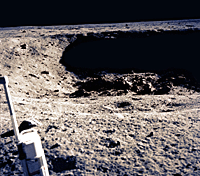
At one point Armstrong disappeared from the TV camera for about 3 minutes to
photograph East Crater about 60 meters away from the LM. He estimated the crater
was about 70 or 80 feet in diameter and 15 or 20 feet deep. The crater wall in
the background is in deep shadow. The object at lower left is the
stereo close-up camera.
(NASA photo ID AS11-40-5954)
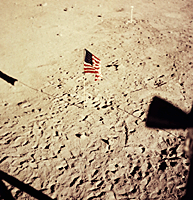
The astronauts returned to the Lunar Module after 2 hours and 32
minutes on the surface and took this picture.
The footprints of the astronauts and the lunar surface television
camera can be seen. The flag was actually knocked over when by
the LM's exhaust when the astronauts took off from the Moon
at 1:54 p.m. EDT on July 21.
(NASA photo ID AS11-37-5545)

After lifting off from the lunar surface, the lunar module made its rendezvous
with the command module. The Eagle docked with Columbia,
and the lunar samples were brought aboard. The LM was left behind
in lunar orbit while the three astronauts returned in the command module to the
blue planet in the background.
(NASA photo ID AS11-44-6642)
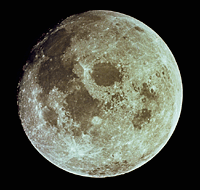
View of a full Moon photographed from the Apollo 11 spacecraft during its
transearth journey homeward. When this picture was taken the spacecraft was
about 10,000 nautical miles from the Moon, after a successful burn of the
command/service module main engine to leave lunar orbit. After a two and
a half day coast the astronauts would re-enter Earth's atmosphere.
(NASA photo ID AS11-44-6667)
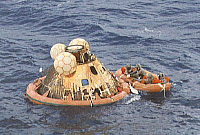
The final phase of Kennedy's challenge
was completed at 12:50 p.m. EDT on
July 24, 1969, when the Columbia splashed down about 812 nautical
miles southwest of Hawaii, returning the 3 astronauts safely to
Earth. Here they are shown in a life raft with a Navy frogman.
All four men are wearing biological isolation garments, awaiting
helicopter pickup and transport to the U.S.S. Hornet. They
stayed in quarantine for three weeks.
The day before splashdown, Aldrin said, "We feel this
stands as a symbol of the insatiable curiousity of all
mankind to explore the unknown." It also stands as a tribute to the
thousands of engineers, scientists, and others who made the journey
possible with their extraordinary efforts.
(NASA photo ID S69-21698)
To order hardcopy versions of any of the AS11- images above, contact the NSSDCA Request Office at nssdc-request@lists.nasa.gov, (301) 286-6695.
 the Apollo 11 home page
the Apollo 11 home page
 Apollo 11 Mission Summary
Apollo 11 Mission Summary
 the Apollo home page
the Apollo home page
 Three asteroids named for Apollo 11 crew
Three asteroids named for Apollo 11 crew
Other Apollo 11 sites:
 Apollo 11 30th Anniversary Page
- NASA History Office
Apollo 11 30th Anniversary Page
- NASA History Office
 Apollo 11 30th Anniversary
- List of Events
Apollo 11 30th Anniversary
- List of Events
 The First Lunar Landing
- Astronauts' Post-Flight Press Conference
The First Lunar Landing
- Astronauts' Post-Flight Press Conference
 Apollo 11 images at Johnson Space Center
Apollo 11 images at Johnson Space Center
 Apollo 11 Lunar Surface Journal
- Transcript of Apollo 11 communications
Apollo 11 Lunar Surface Journal
- Transcript of Apollo 11 communications
 Washington goes to the Moon
- American University Radio
Washington goes to the Moon
- American University Radio
 Apollo 11 Mission Overview
- Lunar and Planetary Institute
Apollo 11 Mission Overview
- Lunar and Planetary Institute
 Apollo 11 Mission Summary
- Kennedy Space Center
Apollo 11 Mission Summary
- Kennedy Space Center
 Apollo 11 Information
- National Air and Space Museum
Apollo 11 Information
- National Air and Space Museum
 Apollo 11 30th Anniversary
- National Space Society
Apollo 11 30th Anniversary
- National Space Society
 Apollo 11 30th Anniversary
- Boeing
Apollo 11 30th Anniversary
- Boeing
